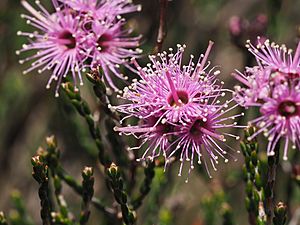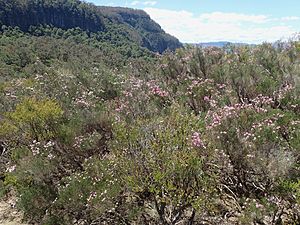Kunzea opposita facts for kids
Quick facts for kids Kunzea opposita |
|
|---|---|
 |
|
| Kunzea opposita in New England National Park | |
| Scientific classification | |
| Genus: |
Kunzea
|
| Species: |
opposita
|
Kunzea opposita is a special plant from the Myrtaceae family, which is also known as the myrtle family. This plant is found only in eastern Australia, meaning it's endemic there. It's a tall, thin shrub with small leaves that grow in pairs. Its pretty pink flowers have five petals and many long stamens. You can usually find it growing in woodlands or on rocky cliffs.
What Does Kunzea opposita Look Like?
Kunzea opposita is a tall, thin shrub. It can grow from about 0.5 m (2 ft) (1.5 feet) to 3 m (10 ft) (10 feet) tall. Its young stems have tiny, soft hairs on them.
Its leaves usually grow in pairs, one on each side of the branch. They are shaped like narrow eggs. Each leaf is only about 1 mm (0.04 in) to 3 mm (0.1 in) long. They are less than 1 mm (0.04 in) wide. The leaves have a very short stem, called a petiole. These leaves are also glabrous, which means they are smooth and hairless.
The flowers grow in round groups of five to nine flowers. You'll find these groups at the ends of the branches. Each flower has special leaf-like parts called bracts. These bracts are shaped like a spear or an egg. They are about 2 mm (0.08 in) to 3 mm (0.1 in) long. There are also smaller paired bracts, called bracteoles, at the base of each flower.
The bottom part of the flower, called the floral cup, is about 3 mm (0.1 in) to 4 mm (0.2 in) long and feels hairy. The sepals are small, triangular, or egg-shaped. They are about 1 mm (0.04 in) to 1.5 mm (0.06 in) long and can sometimes be hairy.
The petals are pink and shaped like an oblong or a wide egg. They are about 1.5 mm (0.06 in) long. Each flower has many stamens, usually between 40 and 50 of them. These stamens are arranged in several rows. They are quite long, about 3 mm (0.1 in) to 5 mm (0.2 in) long.
Kunzea opposita flowers from August to November. After the flowers, it grows fruit. The fruit is a dry, urn-shaped capsule. It's about 3 mm (0.1 in) long and wide. The sepal lobes stay attached to the capsule.
How Did It Get Its Name?
The plant Kunzea opposita was first officially described in 1867. This description was made by a famous botanist named Ferdinand von Mueller. He published his findings in a book called Fragmenta phytographiae Australiae.
The second part of its scientific name, opposita, is a Latin word. It means "on the other side" or "contrary." This name likely refers to how the leaves grow in opposite pairs on the stem.
Where Does Kunzea opposita Grow?
This type of kunzea plant grows in different places. You can find it in woodlands, forests, or on exposed cliffs. It grows north of the Mount Kaputar National Park in New South Wales. It is also found in the south-east part of Queensland, Australia.


